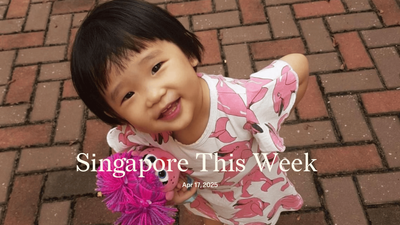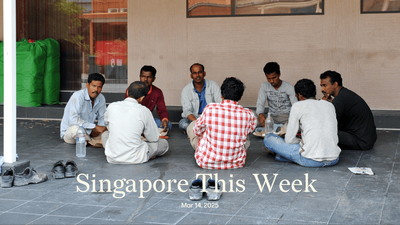Politics: Looking to the skies on National Day
Lee Hsien Loong, the prime minister, delivered a 12-minute National Day message in which he addressed numerous voter concerns, including inflation, ageing, retirement adequacy, and the scandals involving politicians in his ruling People’s Action Party (PAP). He mentioned Lawrence Wong, his deputy and designated heir, numerous times, perhaps a sign that he’s finally ready for a leadership transition, years after he first said he might step down. “The goal of Forward Singapore is to refresh our social compact,” he said of Wong’s signature campaign. “Every citizen has a meaningful part to play in our society and our shared future.” (Two young Singaporeans share their hopes for Forward Singapore in a Jom essay today.) The biggest sign that the party is readying itself for the polls—a general election must be called by 2025—was his emphasis on keeping public housing affordable, the primary bugbear for many voters. Lee delivered his message from a sky garden at SkyOasis@Dawson, a 45-storey Housing Development Board (HDB) complex in Queenstown. Known for its spider-themed playground and pricey top-floor units with panoramic views, the complex’s added symbolism is around public housing regeneration. SkyOasis@Dawson, completed in 2021 in one of Singapore’s oldest towns, is part of HDB’s selective en bloc redevelopment scheme (SERS), through which owners of select ageing, 99-year leasehold flats are forced to sell their units back to the government for redevelopment, with the option to buy a new one nearby. SERS is one way to mitigate worries about “lease decay”, a central housing policy challenge. “We will have to adjust HDB’s housing schemes to achieve these goals [being fair and inclusive]. We have some ideas on how to do so which I will share at the National Day Rally [on Aug 20th].” If the PAP’s housing proposals are ambitious enough, and manage to adequately balance the interests of current flat owners, prospective ones, and the state’s coffers, it may regain some voter confidence lost amid the recent scandals. Separately, at around 12.40pm on National Day, the Singapore Air Force scrambled two F-16s in response to a suspected intrusion into our air space by a Malaysian civilian helicopter. Much ado about nothing, as is common in these occasional territorial spats with the country to which we once belonged. But useful fodder for those needing to justify why we spend so much on weapons—many of which were on public display that very same evening.
Society: Region a global source for online child porn
Online child sexual exploitation and abuse is on the rise; buoyed by endemic poverty, the internet, high smartphone penetration and technological advances. It’s a “prolific problem” in South-east Asia, said Dawn Barriteau, a Singapore-based special agent of the US Homeland Security Investigations (HSI), which investigates transnational crime and threats. HSI shares information on potential illicit child sexual abuse material (CSAM) with law enforcement agencies in the region, including the Singapore police. “…if we are not working together with our foreign counterparts, these perpetrators will go untouched,” said Barriteau. Last year, a US tipline received more than 32m reports of suspected child sexual exploitation and abuse—up from 29.4m in 2021. Over 99.5 percent involved alleged CSAM, mostly from overseas. Nearly 6.5m reports originated from South-east Asia, mostly from the Philippines, Indonesia and Vietnam. The Philippines, recognised as a global production hub for child pornography—including video, photography and live-streaming—is estimated to export some US$1bn (S$1.3bn) worth of CSAM annually. While Singapore might not account for a significant proportion of the origin of abuse, recent cases here have confirmed an appetite for the consumption of CSAM. In June, 71 UN member states, including the Philippines, Singapore, Thailand and Vietnam, signed a call-to-action for the first time, urging members and the private sector to take “further and faster action” to remove known child porn online. Although governments in the region have introduced laws and toughened penalties to discourage cybersex predators, the borderless, shadowy nature of the crime, combined with the vulnerability of children, make it tough to stamp out online abuse. And since poverty is one of the key factors driving the exploitation of children—some even by their own parents—it’s in our collective interest to ensure that every human earns at least a living wage.
Society: Robot doctors and virtual wards
If Meredith Grey and McDreamy had access to artificial intelligence (AI), “Grey’s Anatomy” might’ve ended after the first season. In today’s modern healthcare industry, AI and virtual tech is proving to be a gamechanger. AI “[has] a big and significant influence in how we deliver care at the population level,” said Professor Kenneth Mak, director-general of health at the Ministry of Health (MOH) during the recent International Conference on Artificial Intelligence in Medicine. Now, healthcare professionals are moving towards using AI to deliver care at an individual level. AI-supported systems could detect abnormalities in X-rays, CT scans and mammograms faster and more accurately than manual interpretations, allowing for earlier interventions and fewer chances of human error. Some AI-driven systems are already up and running. Selena+, an AI programme that reads digital retinal images and identifies diabetic damage with an accuracy of 95 to 97 percent, has been in use in all polyclinics since January 2022. That being said, some healthcare professionals have valid concerns about the legal and moral implications of relying on AI. Will this technological shift push humans out of their roles? How can we ensure data is used ethically by self-learning systems? Tan See Leng, the minister of manpower who is also a qualified medical practitioner, emphasised that it is “important for the government to set the framework and policies for AI to be adopted responsibly.” Similarly, how can we ensure a prudent implementation of virtual wards? The pilot for virtual wards—where patients stay at home with access to round-the-clock treatment via telecommunication with healthcare professionals—has expanded to include all public hospitals in Singapore (except the Institute of Mental Health, for now). Medical care at home may be convenient for patients, and may relieve capacity issues at hospitals, but they bring their own set of potential challenges, including unintentionally shifting some of the burden to workers. One nurse in the pilot visited a patient seven times in three days to administer an antibiotic. As Singapore embraces new ways of providing healthcare, it’s important to ensure that frameworks are in place to protect the interests of both patients and staff.
History weekly by Faris Joraimi
Independent researcher Sarafian Salleh has recently launched his book Tuah Bugis - Chronicles of the Seafaring People of Singapore, the product of 15 years’ worth of interviews with members of our Bugis community, as well as investigations into their centuries-long past. It was published with the support of the Genealogy Society Singapore. Unfortunately, there’s little popular awareness about the Bugis today except the name they lent to Bugis MRT station and the Bugis district around it, which demonstrates all the more the importance of resources like Sarafian’s. Roughly between the 16th and 19th centuries, from their base on the island of Sulawesi, the Bugis developed a trading network spanning the Malay archipelago, from the Strait of Melaka in the west to the northern coast of Australia in the east, where Bugis traders frequently interacted with the Aboriginal peoples. They were key to the international commerce of some local products, like sea-cucumber, a prized object in the Chinese market that was obtained via Bugis collection and transshipment routes. Bugis political power was initially mainly concentrated in a set of small but wealthy sultanates in southwest Sulawesi, especially Boné and Gowa. The latter’s subjugation to the Dutch in the 1666 Makassar War, however, scattered many Bugis leaders and traders in search of new bases. Many sailed west, to the Malay Peninsula and the Riau islands, where their economic and military prowess made them rulers in places like Selangor and Johor. Despite political rivalry between Bugis and Malays, there was also much cooperation and intermarriage, with the assimilated Bugis being identified as Bugis peranakan, “locally born Bugis”. (See how broad that term originally was?) One such famous individual, the scholar Raja Ali Haji, became an authority on Malay language and culture. Predatory Dutch policies in Riau led to waves of Bugis resettling in Singapore in the 1800s, where they were active agents of the infant port-town’s success. Sarafian’s book is available here.
Arts: Singapore’s filmmakers around the world
Filmmaker Nelson Yeo’s “Dreaming & Dying” premiered at the Locarno International Film Festival last week. His first feature film tells the story of three middle-aged friends who reunite on vacation and find themselves in a love triangle. Yeo’s short films have shown at multiple film festivals internationally. His 2020 short “Here Is Not There” took home the Best Singapore Short Film at the 31st Singapore International Film Festival. Also playing at Locarno this year is a short film by Giselle Lin titled, “I look into the mirror and repeat to myself” inspired by the filmmaker’s relationship with her family. Lin, who’s a recent graduate from LASALLE’s Puttnam School of Film & Animation, won the inaugural Locarno Residency in 2022. Locarno isn’t the only international festival to show Singaporean films this year. In May, Anthony Chen’s “The Breaking Ice” premiered at the Cannes Film Festival where it was selected for the Un Certain Regard category. The film is an intimate drama set on the Chinese border with North Korea. Chen’s first feature, “Ilo Ilo”, won the Camera d’Or at Cannes when it premiered 10 years ago in 2013. Director Nicole Midori Woodford is also premiering her debut feature film overseas at the San Sebastián International Film Festival this September. “Last Shadow At First Light” is about a daughter struggling to confront the mystery of her missing mother. Both Yeo and Woodford’s films star Singaporean actor Peter Yu, who first rose to prominence as one of the finalists in 1990’s Star Search. It is not Yu’s first time to Locarno. He played the lead role in Yeo Siew Hua’s 2018 feature “A Land Imagined”, which took home the top prize of the festival, the Golden Leopard.
Tech: Digital banking FOMO
In a sharp move that further cements its presence in the digital payments and banking space, FOMO Group has acquired CapBridge and 1 Exchange, both subsidiaries of the larger CapBridge Financial Group. Through these acquisitions, FOMO Group has obtained additional recognised market operator and capital markets services licences under Singapore’s Payment Services Act. These licences will allow FOMO Group to extend its current corporate payments and banking offerings into new capital markets products. Its customer base will also widen. The overall financial details and valuations of the acquisitions were not disclosed. Other non-retail focused banks include Ant Group’s ANEXT and Green Link Digital Bank. In particular, Ant Group recently pumped in another S$250m into the Singapore-based digital wholesale lender, which was launched in June last year after securing from the Monetary Authority of Singapore (MAS) a digital wholesale bank licence, which limits it to only serving businesses. Separately, Ant Group has made a recent investment in Singapore-based B2B cross-border financing and fulfilment company, Proxtera. It has also partnered with BillEase, a Philippine buy-now-pay-later player, to enable instalment options for merchants on its global platforms. Given the competitiveness within the digital business banking space, FOMO Group’s foray into the capital markets space is an attempt to differentiate itself and improve its competitive positioning.
Tech: MAS cautiously optimistic on Web3, AI with S$150m in fintech funding
Even amidst the various blow ups in Web3 over the last two years—including FTX and Terraform Labs —MAS appears cautiously optimistic about the sector. (Web3 refers broadly to the newer, decentralised architecture characterised by blockchain-based applications and token economics, among other things.) MAS has just updated its Financial Sector Technology and Innovation Scheme (FSTI). First launched in 2015, the first two iterations of FSTI distributed over S$1.2bn across 1,500 projects and led to the creation of over 200 jobs. The initial iterations of the programme focused on enhancing the digital capabilities of traditional financial institutions. MAS claims this has served both institutions and their customers well, especially during the Covid-19 pandemic. The latest iteration of the scheme, FSTI 3.0, will involve a commitment of S$150m over three years, and include three new tracks, including a Centre of Excellence, which supports innovative pilots by financial institutions, corporate venture capital firms and global tech companies with up to S$2m per project. Apart from Web3, MAS will also invest in fintech solutions in the environmental, social, and governance space, while continuing to support AI and data analytics and regtech, which previous FSTI schemes had covered. According to KPMG, Singapore’s fintech funding sank to a three-year low in the first half of 2023. Total deal value dropped by over 41 percent from the second half of 2022, to US$934m (S$1.25b) across 84 deals. Granted, MAS’s latest funding scheme for the fintech sector might seem gargantuan to the average Singaporean but it probably is at best a glimmer of hope in the gloomy fintech sector. One can only hope that it will catalyse even greater deal activity amidst the downturn.
If you enjoy Jom’s work, do get a paid subscription today to support independent journalism in Singapore.







